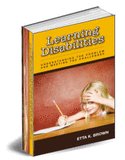|
EXCERPTS FROM CHAPTERS
These excerpts from chapters in our parent guide highlight the most exciting, up-to-date research available regarding causes and prevention of learning disabilities.
Learning disabilities do not prevent children from learning they just require a variety of special instructional methods, that’s why it’s called “special” education... All children can learn, and they do it best through their areas of strength... appropriate teaching methods are the key.
…The home is the child's primary environment. The relationship that a child has with his parents is the primary factor in how the child's brain develops. Chapter III: Immature Development …after kindergarten most classroom failure will not be solved when a child repeats a grade. …studies show that most cases of retention are unsuccessful, and the child is usually hurt by it.
Chapter IV: Parenting Research suggests that the relationship that a parent has with a child has a profound impact on how the child’s mind develops…. Nurturing is the key to maximizing a child’s potential…
Chapter V: Emotional Trauma Brain scans reveal that emotional trauma actually changes the structure and function of the brain…having a significant impact upon emotional, behavioral, cognitive, social and physical development of children.
Chapter VI: Nutrition ..it is accurate to say that the diet of most American children today is a diet that automatically results in a very low level of intelligence….
Chapter VII: Sleep and Learning Given the serious side effects from a lack of sleep…the 2004 Sleep in America Poll suggests that without immediate intervention, the incidence of sleep related learning disabilities will increase into the twenty-second century, and the 2006 poll mirrors these findings…
Chapter VIII: Toxic Metals Some physicians suggest that amalgam fillings and immunizations could be part of the explanation for the explosion of learning problems and autism in children since World War II….
Chapter IX: Laws Which Govern Public Education The rights of parents are numerous, and far supersede those of the school district… Here are your rights simplified for immediate review….
Chapter X: The Individualized Education Plan It is during the development of the Individualized Education Plan that the parent can have the greatest impact upon the future of their child’s education, the rights of parents far superscede those of the school.
Chapter XI: Educational Advocacy As regards special education, the schools have fallen into such a rut of doing what they do in the way in which they do it that parents still need to advocate for an appropriate education for their child in spite of legislation and a history of revised special education law.
Chapter XII: Tests and Testing Without knowledge of specific strengths and weaknesses, the special education teacher may come closer to designing a more relevant program than the classroom teacher, but neither teacher will come close to designing an "appropriate" one… Chapter XIII: Special Education Advocacy at its Best Prior to signing the papers you should have been “informed” that special education was not your only option… You should be informed of all the options available to address your child’s learning needs…
Chapter XIV: Visual Processing As many as 80% of children who are reading disabled, including those considered dyslexic, show a deficiency in one or more basic visual skills… of equal importance is the fact that vision is almost always overlooked by parents and educators as one of the roadblocks to learning. The school nurses's exam is not sufficient...
Chapter XV: Auditory Processing When instruction in school relies primarily on spoken language, the child with an auditory processing weakness may have varying degrees of difficulty understanding the lesson or the directions…. The way teacher and/or parent communicates with the child is the key...
Chapter XVI: Sensori-Motor Integration Assuming the absence of other forms of environmental trauma, research suggests a relationship between under-developed sensori-motor skills and children spending hours sitting still in front of the television playing video games or interacting with a computer. Chapter XVII: Attention A common misconception about children with attention problems is that they aren’t paying attention at all. But children who struggle with attention may actually pay attention to everything...their difficulty is deciding what to focus on and maintaining that focus… He should be as inattentive in front of the TV as he is at school. If he is not, then there is a different problem.
Chapter XVIII: Attention Deficit Disorder with Hyperactivity ADHD it is one of the most misunderstood and misdiagnosed of the disabling conditions affecting children… The diagnosis is a set of behaviors exhibited by the child. Behavior is not a disease; and, there is much evidence that the drugs used to treat "the disease" often make the behavior worse, cause damage to the child's nervous system and impede growth.
|






